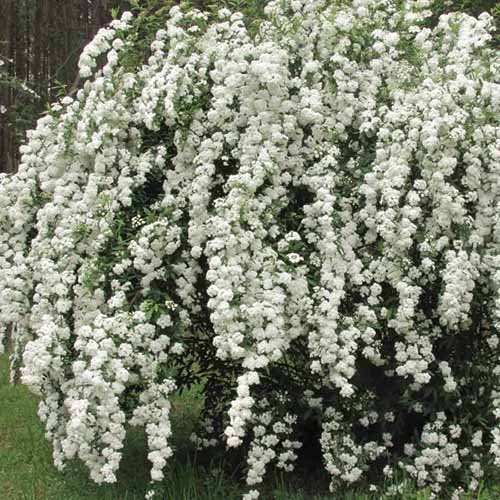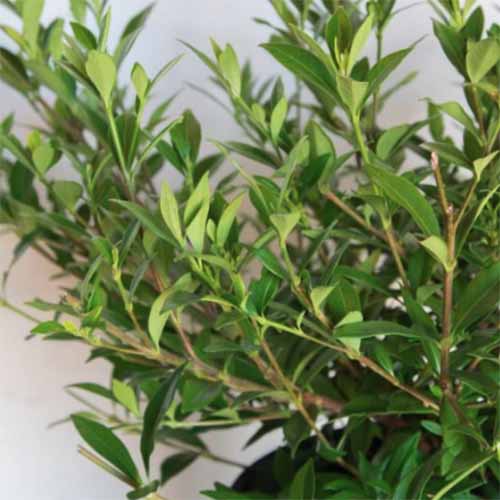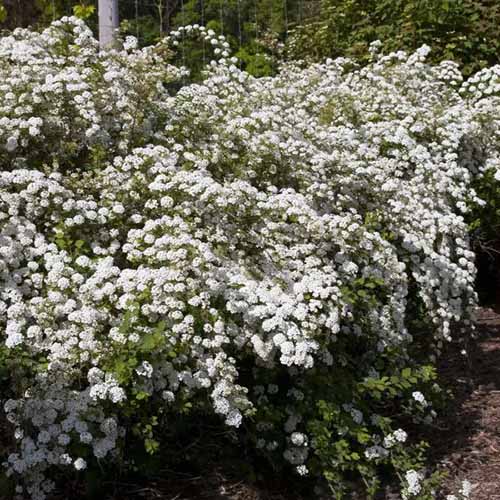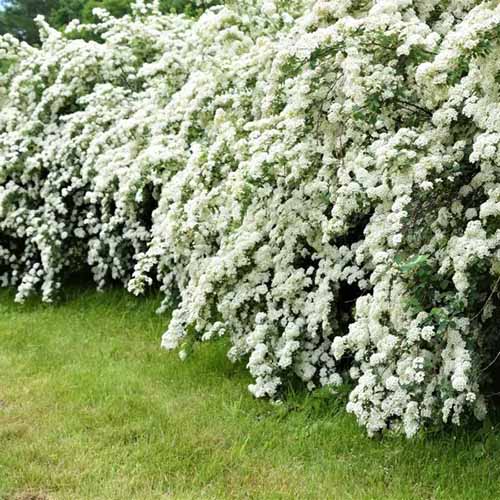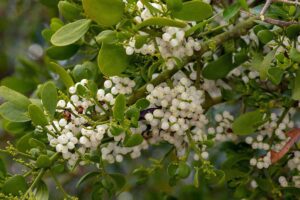Spiraea prunifolia, S. x vanhouttei, S. cantoniensis
Flamboyantly ornamental, bridalwreath spirea is eye-catching to the max, with frothy fountains and spires of pretty flowers in mid-spring.
Masses of small, double-petaled white blossoms cover the arching or upright branches, transforming them into flowing, flowering streams before they leaf out.
The adorable, rose-like blooms have a light fragrance and invite hordes of bees, butterflies, and other helpful pollinators – but plants are left alone by the likes of deer.

We link to vendors to help you find relevant products. If you buy from one of our links, we may earn a commission.
Before flowering has finished, fetching leaves of chartreuse, blue-green, or forest green emerge, adding cool tones to the summer garden until fall when they turn rich shades of burgundy, gold, orange, plum, and scarlet.
With a graceful, elegant form, bridalwreath makes an outstanding specimen shrub in beds, islands, and foundations, as well as adding multi-season interest as barriers, hedges, and seasonal screens.
Easy to cultivate and robust, these plants are cold hardy and go dormant for winter. But even the bare branches add interesting architectural shapes to the sleeping garden – perfect for hanging bird feeders or winter decorations.
Are you feeling the pull of this handsome and hardworking shrub? Then let’s tie the knot on how to grow bridalwreath spirea!
Here’s what you’ll find ahead:
What You’ll Learn
What Is Bridalwreath Spirea?
Bridalwreath spirea is a species in the Spiraea genus, S. prunifolia, that’s native to temperate areas of China, Japan, Korea, and Taiwan where the plants grow on sunny slopes and in open, disturbed areas as well as in meadows.
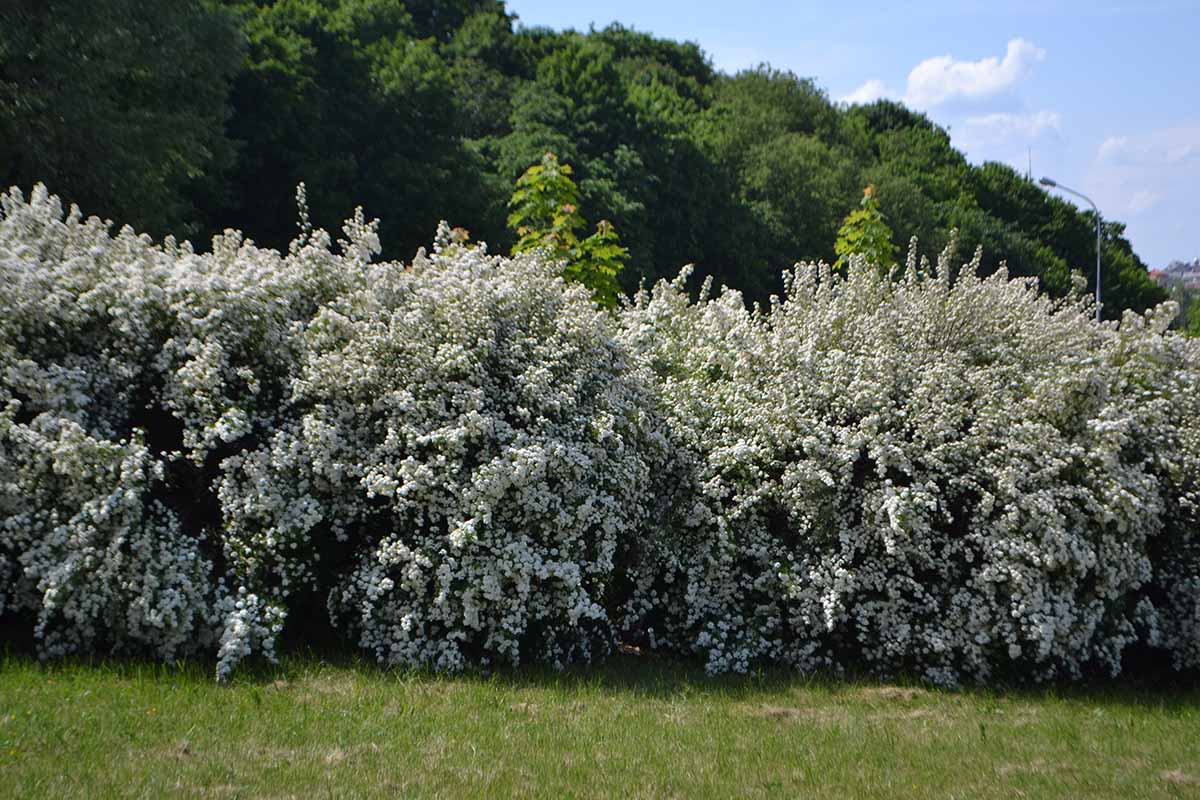
A member of the rose (Rosaceae) family, this deciduous clumping shrub has an upright growth habit and elegant, arching canes.
Bridalwreath is also the common name for one of the first, and one of the most popular Spiraea hybrids known as Vanhoutte spirea, S. x vanhouetti, which is a cross between S. trilobata and S. cantoniensis.
It has the same mounding shape with cascades of white flowers, plus the same growth and cultivation needs as S. prunifolia.
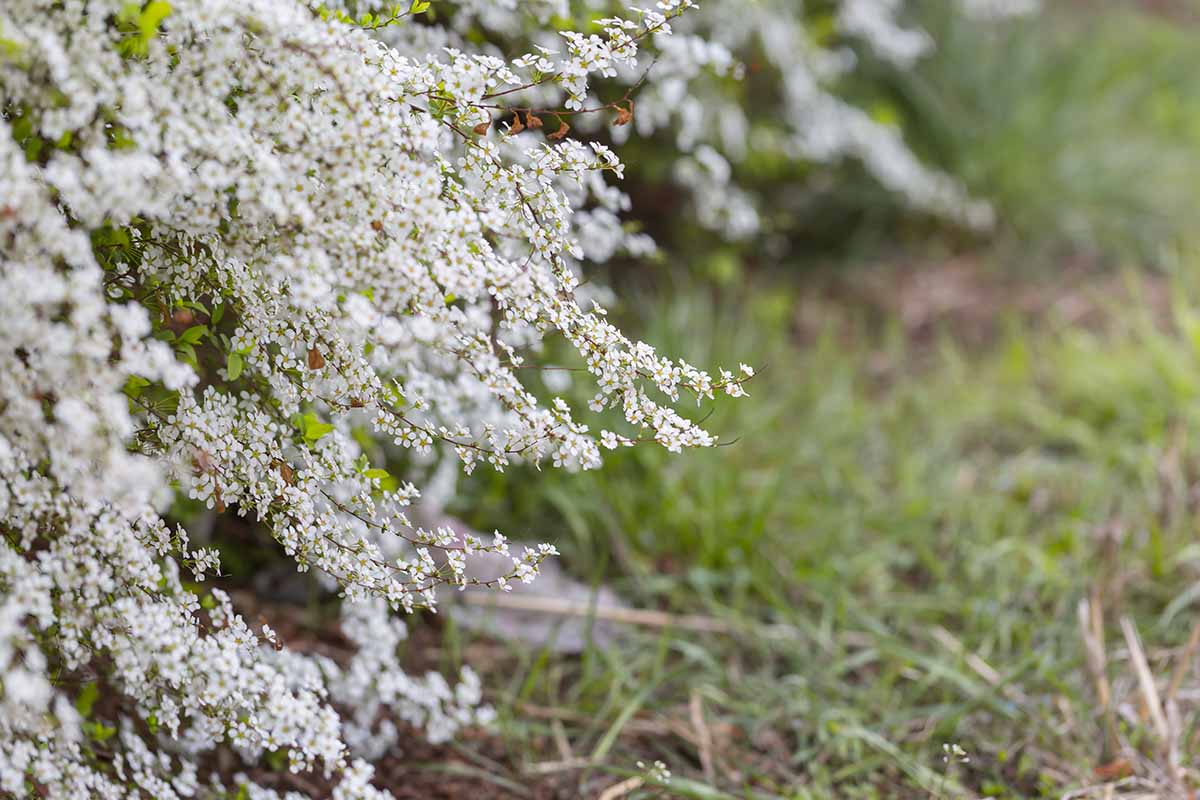
S. cantoniensis is another species that goes by the common name bridalwreath and is one of the parents of the highly popular Vanhoutte types.
Bridalwreath is noted for the masses of double-petaled white flowers that bloom in clusters and corymbs, appearing on bare branches before the foliage emerges, and flowering for three to four weeks. Flowering typically occurs from March to May, depending on the region.
Individual flowers are small, only one-third of an inch in width, and some varieties have single flowers, such as S. prunifolia var. simpliciflora – but they’re difficult to source and don’t bloom for the same length of time as the double flower varieties.
Plants are easily grown in average, well-draining soil in a full sun location, and the seeds are mostly sterile but plants sucker readily.
These shrubs typically grow four to nine feet tall and wide and can develop an open, sprawling form without regular pruning.
The fine-toothed foliage has an elliptic or ovate shape, in colors of blue green to forest green and appears after the flowers are in place.
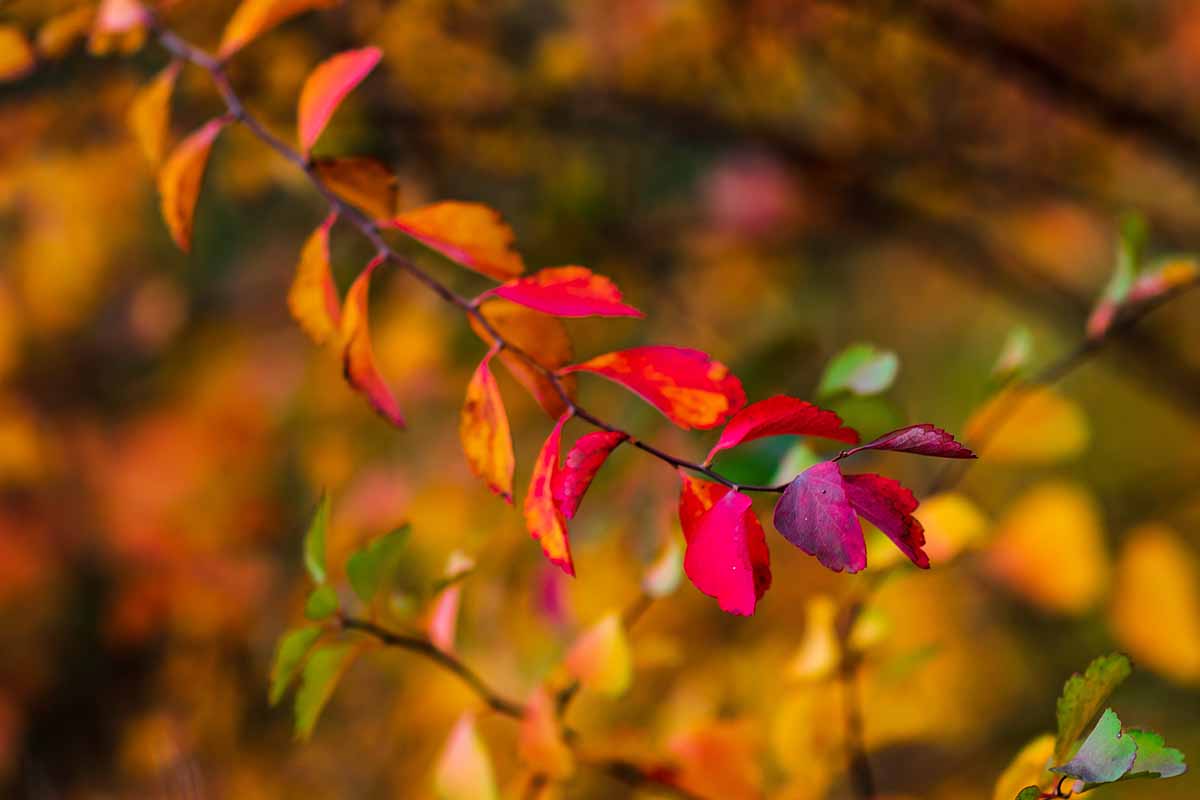
The shrubs develop attractive fall colors, with leaves turning intense shades of burgundy, glowing gold, maroon, fiery orange, plum, and scarlet.
Bridalwreath is a rugged and cold hardy plant, suitable for cultivation in USDA Zones 4 to 8, with some able to handle the colder temperatures of Zone 3 and the warmer temps of Zone 9.
Cultivation and History
The genus name Spiraea comes from the ancient Greek word speiraia, which means a coil and refers to the spiraling, alternate nature of the leaves.
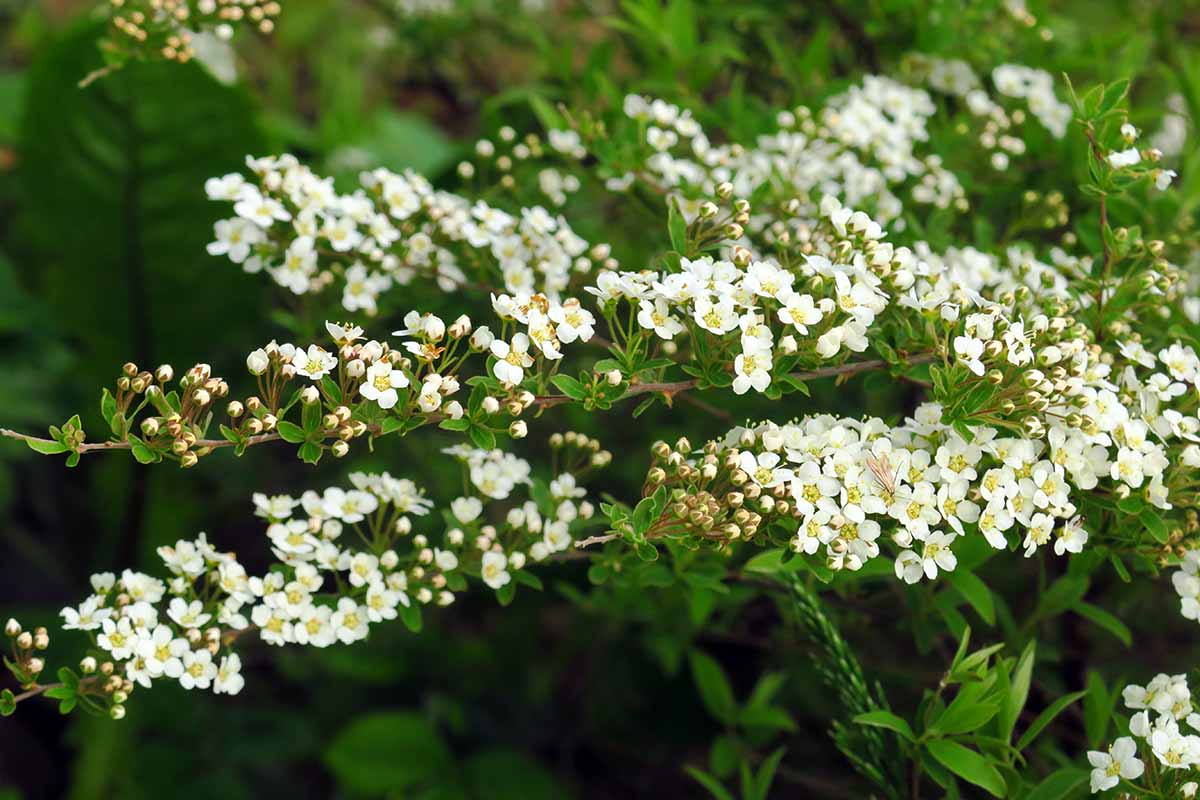
The species epithet prunifolia means it has leaves similar to plants in the Prunus genus.
And the term “bridalwreath” is an old-fashioned moniker that refers to the long, twisting sprays of flowers that were fashioned into wreaths worn on the head for special occasions.
There’s an interesting twist to the naming of the species as well…
When S. prunifolia was discovered by Western botanists in the early 19th century, it was the double flowered form they happened upon – which is not a true botanical species but a hybrid, or horticultural variety, which had long been grown as an ornamental in Japan.
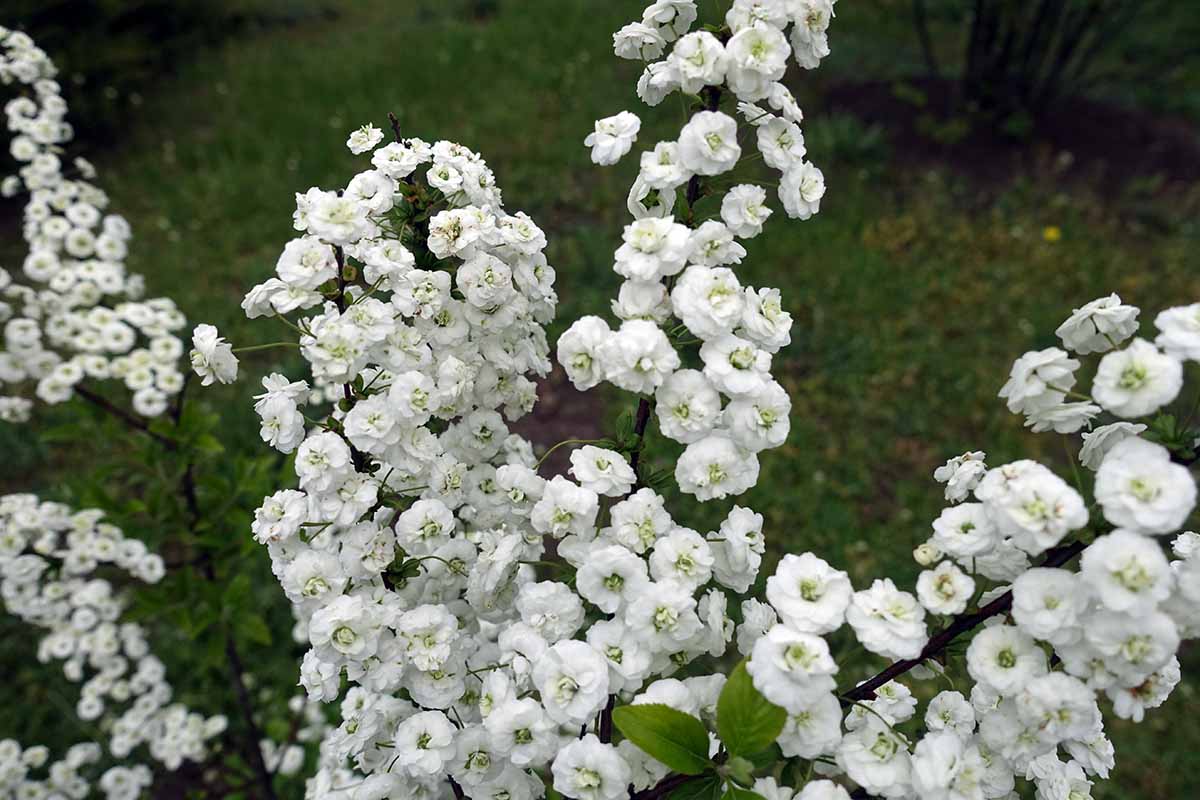
The eager adventurers gave the double flowered variant the species name while the true botanical type – the single flowered plants that grew in the wild – were later discovered and classified as a variety, S. prunifolia var simpliciflora for their simple, single flowers.
Specimens of S. prunifolia became available in Europe by the middle of the 19th century and in North America shortly after. And along the eastern seaboard, there are still remnants of some of the earliest plantings growing at old farmhouse sites, although the buildings are long gone.
The seeds of many varieties are sterile and cultivars don’t reproduce identical to the parents, but plants sucker abundantly and these plants are easily propagated by stem cuttings.
And although there’s a lot of online information stating that bridalwreath is invasive, according to the Invasive Plant Atlas of the US, it doesn’t appear on any state or national invasive species list.
Bridalwreath Spirea Propagation
The easiest and fastest way to propagate bridalwreath spirea is to take softwood cuttings during the growing season.
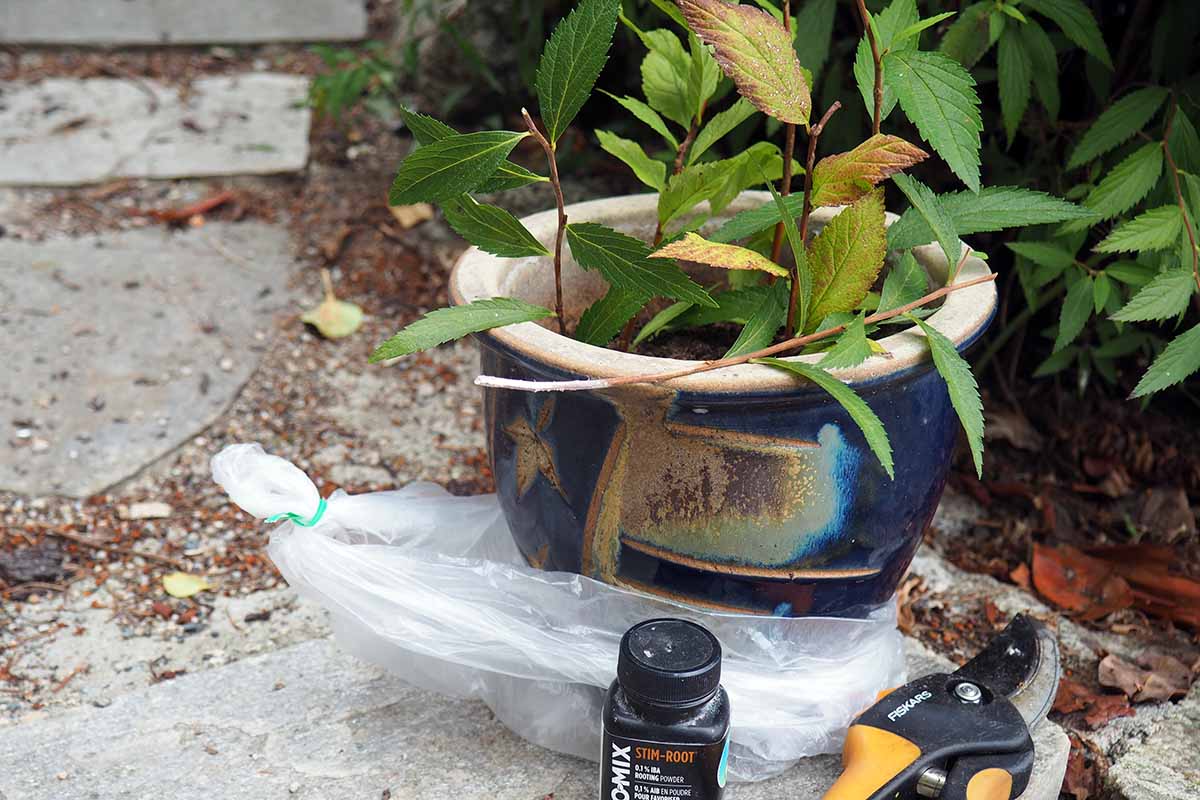
Starting plants from seed is not recommended as the offspring produced don’t always replicate the phenotype, or physical characteristics, of the parent plant.
Propagation through hardwood cuttings and ground layering are also viable options – read about these methods in our guide to three ways to propagate spirea bushes.
To start new plants from softwood cuttings, in late spring to midsummer, cut 10-inch segments of pliable stem tips.
Strip the leaves from the lower half of the snipped stems and dip the cut end in rooting hormone if desired.
Fill a small six-inch pot with moist starter soil and insert four or five prepared stems, spaced evenly and without the leaves touching.
Cover the pots with a plastic bag and seal to retain moisture, but don’t allow the bag to touch the leaves – use chopsticks or small stakes to keep it away from foliage.
Locate the pot in a spot with dappled shade and allow cuttings to root.
Avoid full sun locations, which can cook the tender cuttings, and check occasionally to ensure the soil stays moist. Water gently as needed.
Rooting takes place in four to six weeks. Once new growth appears after rooting, repot cuttings into individual containers and place in full sun for the remainder of the growing season.
Before freezing temperatures arrive, nestle your pots of newly rooted cuttings into a protected site and provide a protective, four-inch mulch of shredded bark or straw to shield the roots.
Plant out in spring after all danger of frost has passed.
How to Grow Bridalwreath Spirea
Bridalwreath is easily grown in well-draining soil with average fertility and a lightly acidic to neutral pH of 6.0 to 7.0. It needs a full sun to partial shade location, although flowering and fall foliage colors are better in full sun.
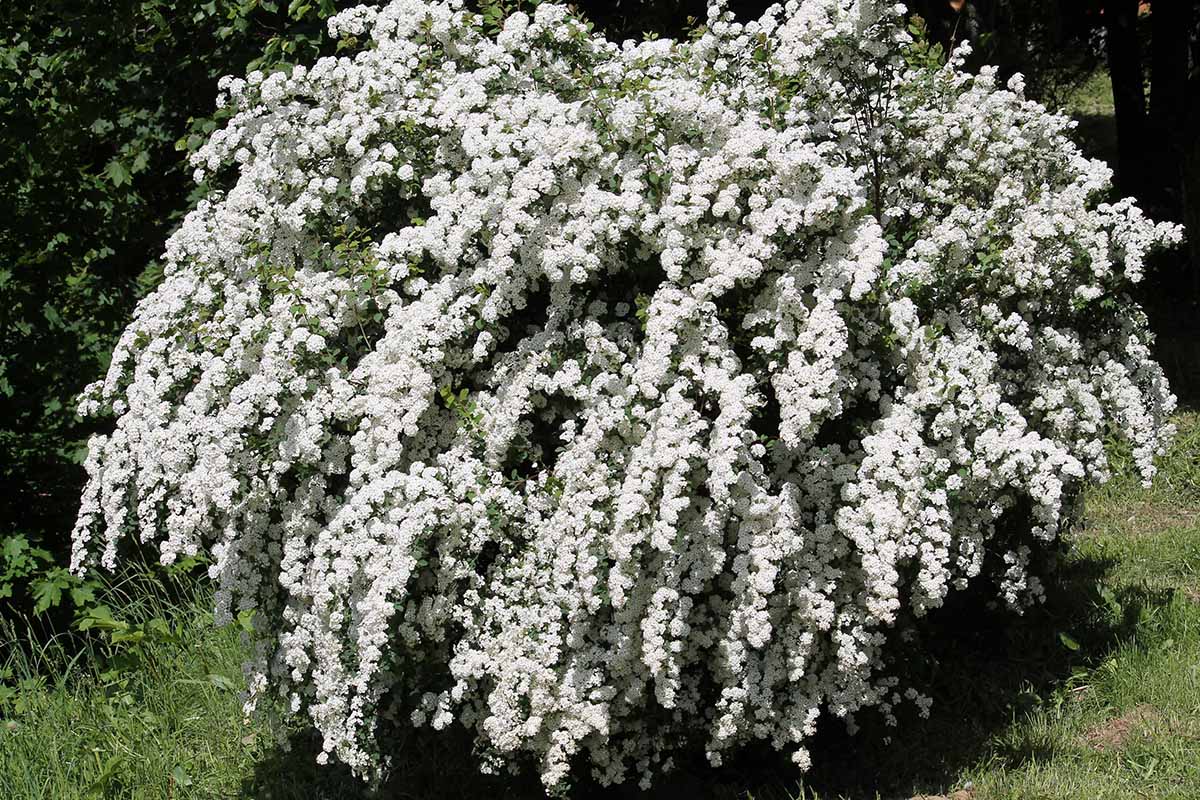
Plant out rooted cuttings or nursery specimens in spring after all danger of frost has passed – this gives them ample time to get settled and established before cold winter weather arrives.
Prepare the planting site by loosening the soil to a depth and width of at least 12 inches, or twice the depth and width of the rootball.
Add in a shovelful or two of organic matter such as compost or well-rotted manure. S. prunifolia plants aren’t heavy feeders, but enriching the soil at planting time helps them off to a good start.
Mix in a shovelful or two of drainage grit if needed, using materials like landscape sand, pea gravel, or stone chips to prevent standing water.
Before planting, mix in two or three tablespoons of bone meal to promote fast, strong root growth.
Set the plants in place at the same depth as their nursery pots, or with the top of the rootball about two inches below the soil line.
Backfill with soil and gently firm in place.
Water lightly to settle and keep the soil lightly moist for new plants until they’re established.
Bridalwreath spirea is somewhat drought tolerant once established but new plants should be watered regularly their first year.
After plants are established, allow the top two or three inches of soil to dry out between waterings.
Not all bridalwreath types are suitable for growing in containers, but there are newer dwarf varieties that adjust nicely to larger planters.
For container growth, use large pots with drainage holes to ensure well-draining soil. I like to cover the drainage holes with two inches of loose materials like broken pottery to prevent wet soil.
Fill containers with your favorite potting soil and transplant as outlined above.
Place containers in a full sun location.
Container plants usually require more frequent watering – allow only the top two inches of soil to dry out between applications.
Growing Tips
Bridalwreath spirea is easily cultivated and the following tips help to keep them looking great:
- Although bridalwreath can handle partial shade, it produces more flowers and brighter fall foliage colors in full sunlight.
- Provide well-draining soil with a pH of 6.0-7.0.
- You may need to water container plants more frequently than those planted in the ground. Allow the top two inches of soil to dry out between applications.
Now let’s move on to what they need for regular maintenance.
Pruning and Maintenance
When left on its own, bridalwreath spirea can develop an open, leggy appearance.
To keep the plant’s size in check or to maintain a tighter form, prune after flowering.
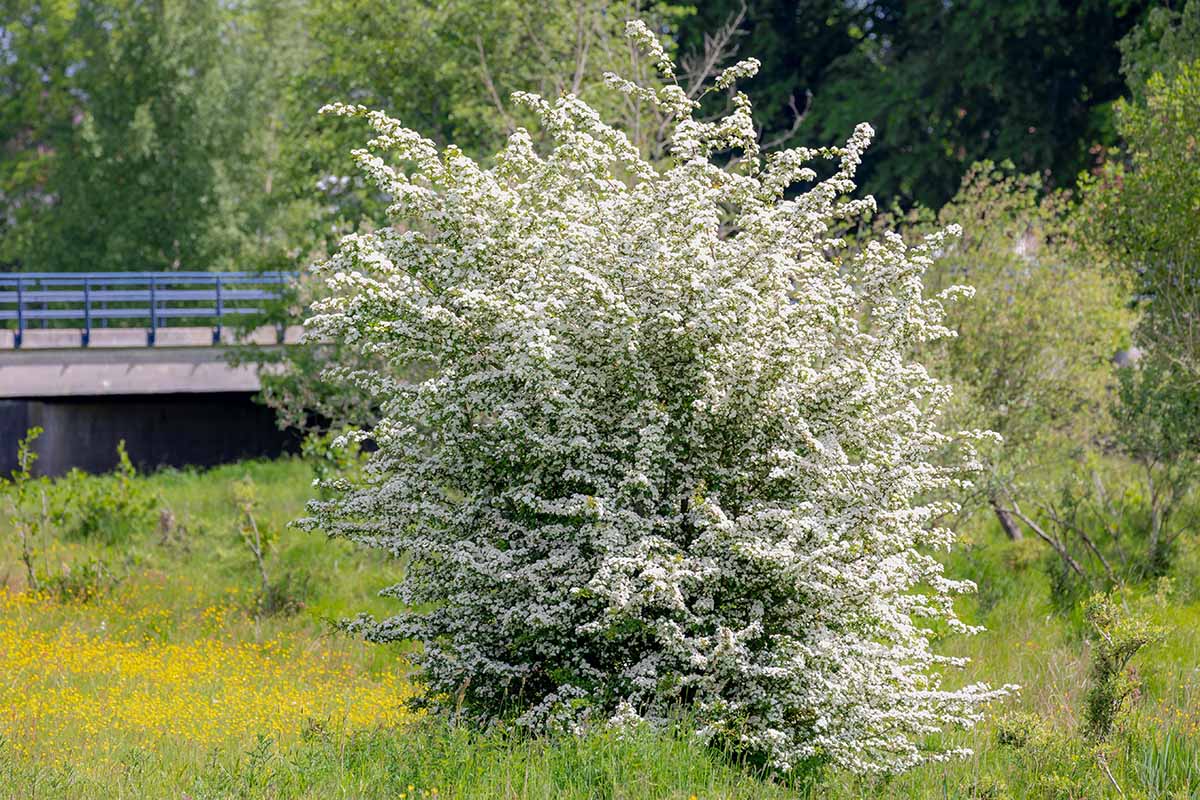
Damaged or dead canes can be cleaned out in late winter but keep in mind that this spring-flowering species produces flowers on old wood – pruning to reshape or resize while they’re dormant should be avoided to prevent flower loss.
However, it’s easiest to thin clumps or remove unwanted suckers while plants are still dormant in late winter.
Use clean, sharp garden shears to thin out canes and remove suckers by cutting them below the soil line.
All other pruning should be done after flowering.
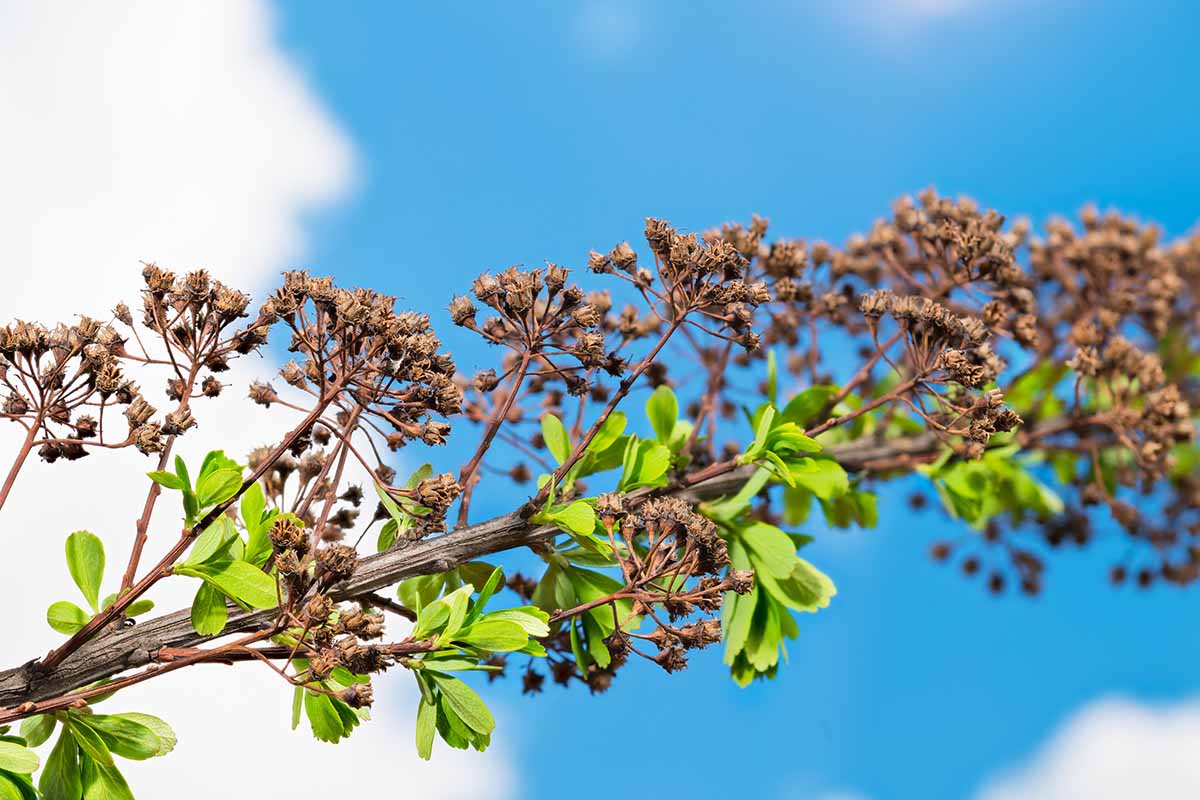
After flowers have faded, deadhead with clean, sharp shears to clean and tidy branches, removing flower clusters at the base where they attach to the canes.
To reduce your shrub’s size or to reshape, use clean, sharp garden shears to cut branching stems just above the collar that attaches them to the main stems.
Avoid cutting back branching stems part way down their length as this encourages branching at the cut, which can cause canes to become tangled and top-heavy and often results in breakage.
You can learn more about pruning spirea in our guide.
To feed your plants, spread a two-inch layer of compost or well-rotted manure over the root zone in early spring once new growth starts to emerge.
Alternatively, you can apply slow-release granular pellets in spring using a balanced formula such as 10-10-10 NPK.
Mature plants require no extra protection for winter but new ones benefit from a four-inch layer of mulch over the root zone to protect against heaving from freeze/thaw cycles.
Learn more about how to care for spirea in winter in our guide.
Bridalwreath Species and Cultivars to Select
With dozens of bridalwreath cultivars, there’s plenty of selection for any garden… here are a few popular choices to get you started.
Old Fashioned
With gorgeous fountains of flowers in a graceful, arching vase shape, the double flowers of old-fashioned bridalwreath (S. prunifolia) are highly impressive in early spring.
The long, reaching canes are covered in blooms before the blue-green foliage appears, which takes on beautiful hues of crimson, orange, purple, and yellow in fall.
Shrubs grow to a mature height of five to nine feet with a spread of six to eight feet and make a handsome barrier, hedge, seasonal privacy screen, or specimen plant. Hardy in Zones 4 to 7.
Nursery containers of bridalwreath are available at Nature Hills and Perfect Plants Nursery.
Reeves
‘Reeves’ is a bridalwreath from the species S. cantoniensis, and features long, arching branches frothing with clusters of double white blooms in spring.
In fall, the dark green leaves turn vibrant shades of burgundy, gold, red, and yellow.
Exceptionally heat and drought tolerant, the deciduous ‘Reeves’ often overwinters as an evergreen in warmer regions and plants are hardy in Zones 4 to 9.
Shrubs grow to a mature height of five to six feet with a width of four to six feet.
A top choice for water-wise gardens, ‘Reeves’ is appealing massed into borders and hedges or as a solo accent in foundations and raised beds.
Shrubs in two-and-a-half-gallon pots are available through Plants By Mail.
Renaissance
A handsome cultivar with a long flowering period, S. x vanhouttei ‘Renaissance’ features masses of tiny white double flowers on gracefully arching branches.
The fountain-shaped shrub has an airy, refined appearance and features beautiful, blue green foliage that takes on shades of orange, red, and purple in fall.
Plants grow to a height of five to seven feet with a spread of six to eight feet and make an outstanding specimen in foundations, islands, and perennial beds.
‘Renaissance’ also has excellent cold hardiness and is suitable for Zones 3 to 7.
Plants in #3 containers are available at Nature Hills.
Vanhoutte
The standard bearer of bridalwreath varieties, Vanhoutte spirea (S. x vanhouttei) is laden with small double white flowers on graceful branches pendulous with blooms in mid to late spring.
The beautiful, vase-like form has elegant, arching limbs and soothing blue green foliage that takes on an overcast of burgundy or purple in autumn, although the fall colors aren’t as vibrant as other cultivars.
These shrubs grow up to eight feet tall and six feet wide and have good cold hardiness, being suitable for Zones 3 to 8.
They make an excellent specimen in foundations and islands or massed into barriers, hedges, and screens.
Bare root plants are available at Nature Hills.
Managing Pests and Disease
Largely free of serious disease and insect problems, bridalwreath spirea can be susceptible to some of the issues that face other members of the rose family.
Aphids are small, gray, green, or black soft-bodied sapsuckers that feed on the fluids in leaves and stems. They can cause leaf yellowing or stunted growth and can leave a trail of sticky honeydew, and aphids transmit problem pathogens as well.
Treat aphids with a strong blast of water from the garden hose, spraying on the underside of infected leaves and stems as well. And check out our guide for more information about eradicating aphids.
Spider mites are tiny pests that thrive in hot, dry weather. They’re also sapsuckers and cause spotting or yellowing of leaves plus leaf drop.
Spray spider mites with the garden hose or use an insecticidal soap for aggressive infestations. Our guide to spider mites has more information.
Fire blight is a destructive bacterial disease that causes stem cankers in spring. These appear first as a loose, green or tan ooze that darkens and streaks stems.
Prune out infected wood several inches below the problem areas and destroy the diseased pieces. Be sure to disinfect your cutting shears between each cut with a 10 perfect chlorine bleach solution (one part chlorine bleach mixed with nine parts water).
Leaf spot can be caused by the spores of soilborne fungi splashing onto leaves and foliage.
The damage is usually mild and can be treated by removing infected stems. Keep beds clean of leaf debris and avoid overhead watering to minimize infestations.
Powdery mildew is another fungal issue that can crop up, covering tender growth in fuzzy webs that dwarfs and stunts new growth and causes leaf drop plus stem collapse.
Prevention is the best treatment for powdery mildew. Plant in full sun with ample air circulation, keep beds free of debris, and avoid overhead watering. Learn more about treating powdery mildew in our guide.
Best Uses for Bridalwreath Spirea
A star in easy-care landscapes, bridalwreath spirea has a range of uses.
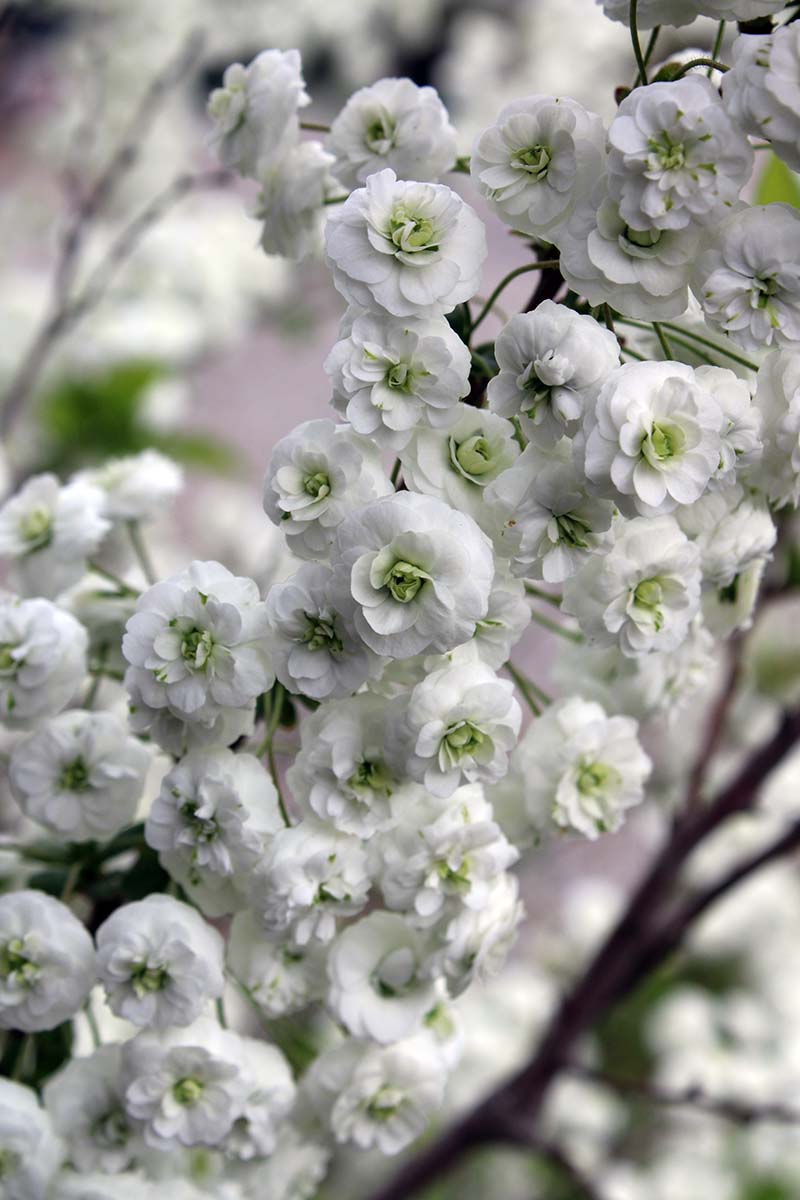
Highly ornamental with three seasons of interest, these handsome shrubs make an excellent flowering specimen or accent for foundations, islands, and layered into mixed shrub plantings.
They’re terrific for adding flowers and fall colors to borders, and can be massed in groups for barriers, hedges, and screens.
And they’re outstanding for filling a sunny, neglected corner of your garden or for dotting woodland margins.
Quick Reference Growing Guide
| Plant Type: | Deciduous woody shrub | Flower / Foliage Color: | White/blue green, chartreuse, forest green with fall colors of burgundy, crimson, gold, orange, and purple |
| Native to: | China, Japan, Korea, Taiwan | Maintenance: | Low |
| Hardiness (USDA Zone): | 4-8, some to Zone 3 | Tolerance: | Deer, some drought |
| Bloom Time/Season: | Spring (colorful foliage in fall) | Soil Type: | Average |
| Exposure: | Full sun to part shade | Soil pH: | 6.0-7.0 |
| Time to Maturity: | 1-3 years | ||
| Spacing: | 6-8 feet | Soil Drainage: | Well-draining |
| Planting Depth: | Same depth as nursery pots or top of the rootball two inches below the soil line (transplants) | Attracts: | Bees, butterflies |
| Height: | Up to 9 feet | Uses: | Specimen in foundations, islands, and mixed shrub beds, massed for barriers, hedges, screens |
| Spread: | Up to 8 feet | Family: | Rosaceae |
| Water Needs: | Moderate | Genus: | Spiraea |
| Common Pests and Diseases: | Aphids, spider mites; fire blight, leaf spot, powdery mildew | Species: | Cantoniensis, prunifolia, x vanhouttei |
Outstanding Ornamental Value
With its elegant, arching shape, abundant clusters of spring flowers, and vivid fall colors, bridalwreath spirea provides outstanding ornamental value.
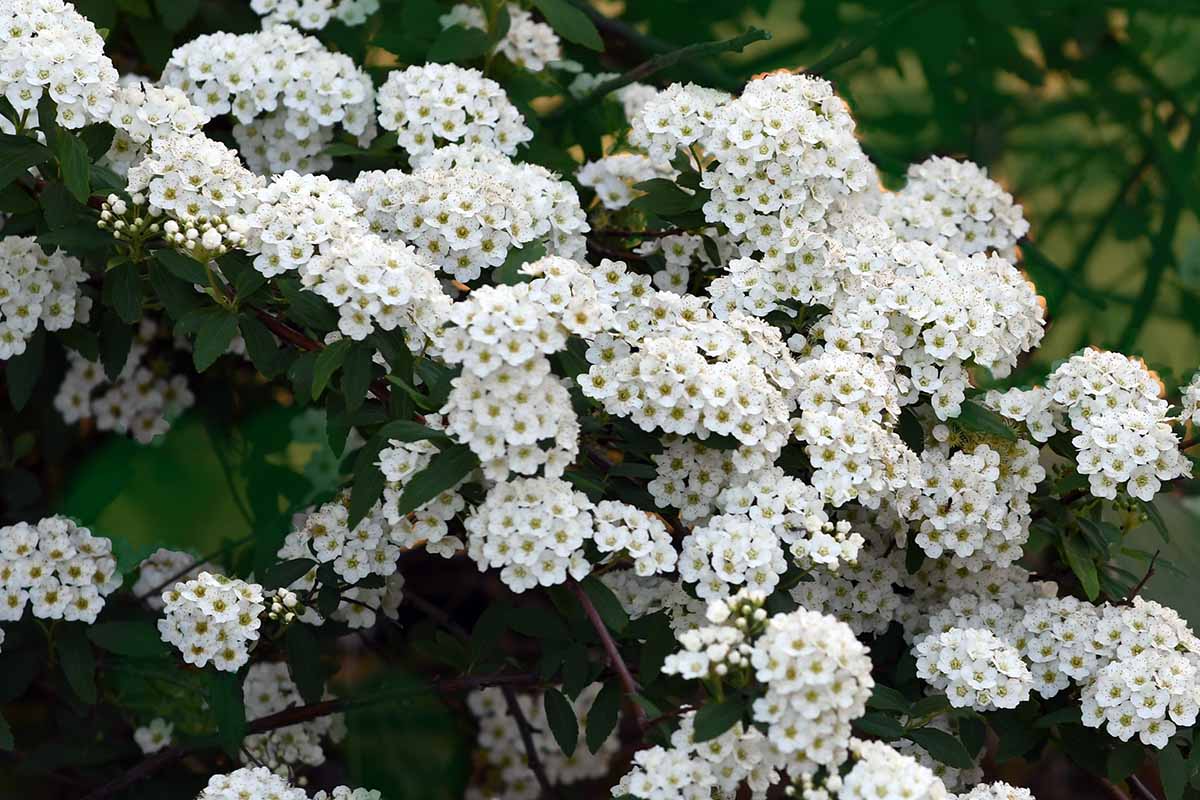
Low-maintenance and easily cultivated, keep the soil lightly moist until roots are established, prune after flowering, and fertilize in spring for vigorous, healthy shrubs – and plant in full sun for the best autumn colors!
How do you folks use bridalwreath spirea in the landscape? Tell us about it in the comments section below.
And for more spirea know-how, add these guides to your reading list next:
